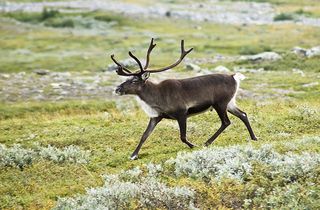North Pole's Reindeer Population Plummets

Reindeer populations worldwide are decreasing, according to the authors of a new study who hope that measures soon will be taken to save the majestic and iconic winter holiday animals.
Strengthening reindeer populations would have far reaching effects, according to the study, published in the Journal for Nature Conservation. Ecosystems, local economies and even climate change are just some of the matters that could be impacted, and not just in the northernmost polar region.
"Reindeer occur in the northern part of the Arctic and subarctic region," lead author Xiuxiang Meng explained to Discovery News. "In northern Europe (such as in Finland, Sweden and Norway), Asia (Russia, Mongolia and China) and North America (Canada and Alaska), reindeer populations have been declining for many years."
Meng, a professor at Renmin University's School of Environment and Natural Resources, and his colleagues further note that there are two subspecies of reindeer in the world: tundra reindeer and woodland reindeer. Some are wild or feral, while others are considered to be "semi-domesticated." The various types, also known as caribou, appear to be experiencing population decreases.
The researchers focused their study on reindeer in China, since the hoofed mammal's population there has declined at least 28 percent since the 1970s. Meng and his team said that reindeer in China originated from Siberia about 2000 years ago, migrating with the Ewenki people, who have been called "the last hunting tribe of China."
The Ewenki have never tamed or fully domesticated the reindeer, which feed on their own. People just provide basic herd management, such as provisioning the animals with salt. The Ewenki benefit from the reindeer's meat, hides, antlers, milk and other things.
The researchers, however, believe that at least six factors are causing the reindeer population to decline. The first is inbreeding. Since reindeer populations here and in other locations are low, there is a greater risk for genetic deterioration. The second factor is poaching, often for the very same antlers that grab our attention on holiday cards.
Sign up for the Live Science daily newsletter now
Get the world’s most fascinating discoveries delivered straight to your inbox.
The third are natural predators. As the scientists mention, "Bears, wolves and lynx are the three main predators of reindeer, and may kill as many as a third of reindeer calves each year."
Ice Age Drove Split Between Reindeer and Caribou
Lack of herders and breeders, climate change, and changes to the tourism industry round out the list. To attract more tourists, herders have been moving closer to where people tend to congregate, putting reindeer at risk from traffic, the aforementioned poaching and other problems.
Achyut Aryal, a researcher at Massey University, echoed the concerns. He told Discovery News that disease is yet another threat to reindeer populations worldwide.
Both he and Meng believe that the IUCN Red List Data on reindeer needs to be updated. As it stands, reindeer are classified as being of "least concern," in terms of their conservation status. This is based on a 2008 assessment.
"The semi-domesticated (reindeer) population in China, Mongolia and Russia—and especially China—should be given enough concern by the IUCN Red List," Meng said. "Our survey showed that the reindeer in China comprise the southernmost reindeer population in the world, which is so important to the distribution and conservation of reindeer worldwide."
Meng and his team are working on yet another study to determine how reindeer herding first emerged in the world. They have data supporting that reindeer herding originated in forests located in Russia, Mongolia and China.
Originally published on Discovery News.
